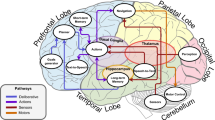Abstract
Deliberate control of an entertainment robot presents a special problem in balancing the requirement for intentional behavior with the existing mechanisms for autonomous action selection. It is proposed that the intentional biasing of activation in lower-level reactive behaviors is the proper mechanism for realizing such deliberative action. In addition, it is suggested that directed intentional bias can result in goal-oriented behavior without subsuming the underlying action selection used to generate natural behavior. This objective is realized through a structure called the intentional bus. The intentional bus serves as the interface between deliberative and reactive control by realizing high-level goals through the modulation of intentional signals sent to the reactive layer. A deliberative architecture that uses the intentional bus to realize planned behavior is described. In addition, it is shown how the intentional bus framework can be expanded to support the serialization of planned behavior by shifting from direct intentional influence for plan execution to attentional triggering of a learned action sequence. Finally, an implementation of this architecture, developed and tested on Sony’s humanoid robot QRIO, is described.
Similar content being viewed by others
Explore related subjects
Discover the latest articles, news and stories from top researchers in related subjects.References
Andronache V, Scheutz M (2002) Contention scheduling: a viable action-selection mechanism of robotics? In: Proceedings of the 13th midwest AI and cognitive science conference. AAAI, New York, pp 122–129
Arkin R (1998) Behavior-based robotics. MIT Press, Cambridge
Arkin R, Clark R, Ram A (1992) Learning momentum: on-line performance enhancement for reactive systems. In: Proceedings of the 1992 IEEE international conference on robotics and automation, pp 111–116
Arkin R, Fujita M, Takagi T, Hasegawa R (2003) An ethological basis for human–robot interaction. Robot Autonomous Syst 42(3–4): 191–201
Blumberg B (1994) Action-selection in hamsterdam: lessons in ethology. In: Proceedings of the third international conference on the simulation of adaptive behavior, pp 108–117
Bonasso R, Kortenkamp D (1994) An intelligent agent architecture in which to pursue robot learning. In: Working notes: MCL-COLT ’94 robot learning workshop
Brazeal C (2000) Sociable machines: expresive social exchange between humans and robots. Ph.D. thesis, MIT Press, Cambridge
Burgard W, Cremers A, Fox D, Hähnel D, Lakemeyer G, Schulz D, Steiner V, Thrun S (1998) Interactive museum tour-guide robot. In: Proceedings of AAAI-98, pp 11–18
Carpenter P, Riley P, Veloso M, Kaminka G (2002) Integration of advice in an action selection architecture. In: Proceedings of the RoboCup2002 symposium, pp 195–205
Cheranova S, Arkin R (2007) From deliberative to routine behaviors: A cognitively-inspired action selection mechanism for routine behavior capture. Adapt Behav 15(2): 199–216
Cooper R, Shallice T (1997) Modeling the selection of routine action: Exploring the criticality of parameter values. In: Proceedings of the 19th annual conference of the cognitive science society, pp 130–135
Cooper R, Shallice T (2000) Contention scheduling and the control of routine activities. Cognit Neuropsychol 17(4): 297–338
Fujita M, Kuroki Y, Ishida T, Doi T (2003) Autonomous behavior control architecture of entertainment humanoid robot SDR-4X. In: Proceedings of the IEEE/RSJ international conference on intelligent robots and systems, pp 960–967
Garforth J, Meehan A (2005) Driven by novelty? Integrating executive attention and emotion for autonomous cognitive development. In: Proceedings of the developmental robotics AAAI spring symposium
Garforth J, Meehan A, Mc Hale S (2000) Attentional behavior in robotic agents. In: Proceedings of the international workshop on recent advances in mobile robots
Gat E (1997) Artificial intelligence and mobile robots. MIT/AAAI Press, Cambridge
Glasspool D (2000) The integration of control and behavior: Insights from neuroscience and AI. In: Proceedings of the how to design a functioning mind symposium at AISB-2000, pp 77–84
Hoshino Y, Takagi T, Profio UD, Fujita M (2004) Behavior description and control using behavior module for personal robot. In: Proceedings of the 2004 international conference on robotics and automation, pp 4165–4171
Lyons D, Hendricks A (1992) Planning for reactive robot behavior. In: Proceedings of the IEEE international conference on robotics and automation, pp 2675–2680
Maes P (1989) How to do the right thing. Connect Sci J 1(3): 291–323
Mastrogiovanni F, Sgorbissa A, Zaccari R (2004) A system for hierarchical planning in service mobile robots. In: Proceedings of IAS08
Moshinka L, Arkin R (2003) On TAMEing robots. In: Proceedings IEEE conference on systems, man, and cybernetics, pp 3949–3959
Norman DA, Shallice T (1986) Consciousness and self regulation: advances in theory and research. Attention to action: willed and automatic control of behavior, vol 4. Academic Press, New York
Okada K, Haneda A, Nakai H, Inaba M, Inoue H (2004) Environment manipulation planner for humanoid robots using task graph that generates action sequence. In: Proceedings of 2004 international conference on intelligent robots and systems, pp 1174–1179
Payton D, Rosenblatt J, Keirsey D (1990) Plan guided reaction. IEEE Trans Syst Man Cybernet 20(6): 1370–1382
Rosenblatt J (1997) DAMN: A distributed architecture for mobile navigation. J Exp Theor Artif Intell 9(2): 339–360
Schallice T, Burgess P (1996) The domain of supervisory processes and temporal organization of behavior. Philos TransRoy Soc London B 351: 1405–1412
Wagner A, Arkin R (2003) Internalized plans for communication-sensitive team behaviors. In: Proceedings of the international conference on intelligent robotics and systems, pp 2480–2487
Author information
Authors and Affiliations
Corresponding author
Rights and permissions
About this article
Cite this article
Ulam, P.D., Arkin, R.C. Biasing behavioral activation with intent for an entertainment robot. Intel Serv Robotics 1, 195–209 (2008). https://doi.org/10.1007/s11370-008-0021-8
Received:
Accepted:
Published:
Issue Date:
DOI: https://doi.org/10.1007/s11370-008-0021-8




